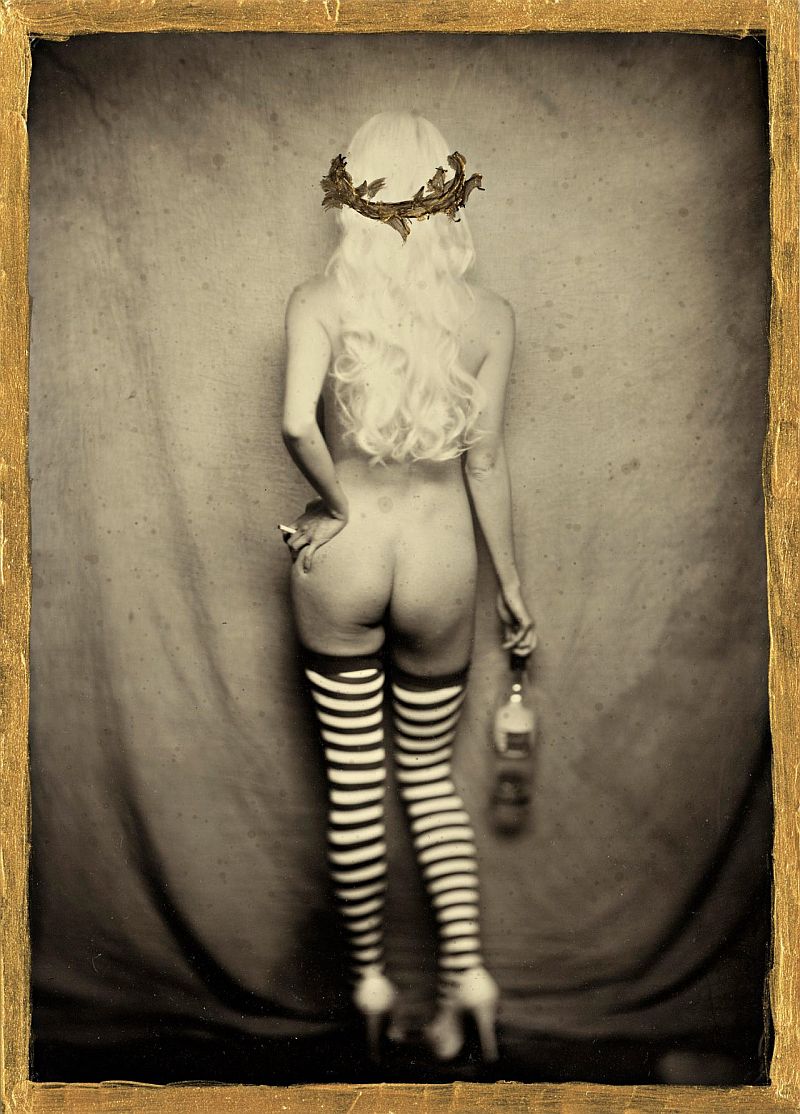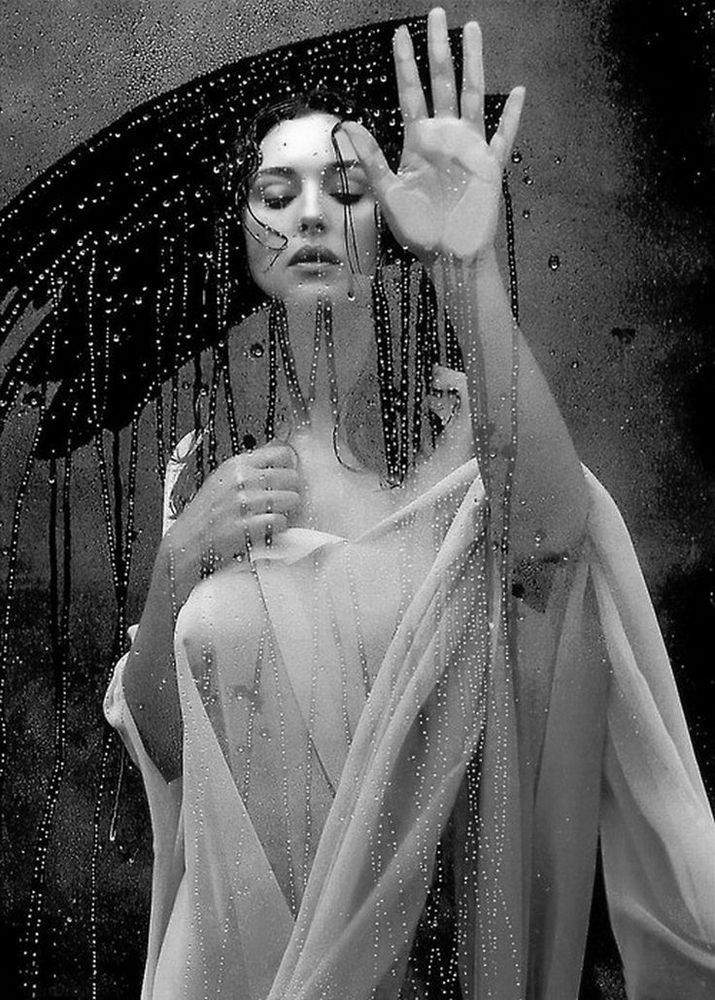J.A.W. Cooper
"Tarde del gavial / Gharial Afternoon", fotografía, aguada / photograph, gouache, 9" x 12", 2014
J.A.W. Cooper nació en Inglaterra, y se crió con sus padres, ecologistas de aguas dulces, por todo el globo (Kenya, Suecia, Irlanda, etc.).
Actualmente vive en el centro de Los Ángeles, California.
Estudió Artes de la Comunicación en el Otis College de Arte y Diseño entre 2005-09, tiempo durante el cual obtuvo su Licenciatura en Bellas Artes. Desde que se graduó, se ha establecido como una exitosa ilustradora freelance y artista plástica muy requerida.
"Espectros / Specters"
Óleo y acrílico sobre Stonehenge montado / oil and acrylic on mounted Stonehenge, 33" x 25", 2010
«Me planteé hacer carrera en zoología y me apunté a muchos colegios, en algunos para zoología y en otros para arte. Fui a todos ellos y entonces entonces tuve que decidir, y escogí seguir con el arte como carrera, y dejé mi pasión por la ciencia y la zoología de lado. Sospechaba que si me situaba en un entorno que realmente me impulsara técnica y conceptualmente podría ser muy competitiva profesionalmente y hacer carrera con ello, así que decidí ir durante 4 años a un colegio de arte.»
"Moteada / Dappled", grafito, tinta, aguada / graphite, ink, gouache, 2012
"Rencor / Bad Blood", tinta india y aguada sobre papel / India ink and gouache on paper, 5" x 8", 2014
«Esta carrera requiere que inviertas una gran parte de tí misma (tus miedos, esperanzas, experiencias y percepciones) en tu obra, y al mismo tiempo exige que mantengas la suficiente distancia como para ser crítica con tu trabajo. Es un equilibrio difícil entre vulnerabilidad y profesionalismo, y mientras debes estar satisfecha con tu esfuerzo y crecimiento, nunca debes estarlo con lo que produces, y de alguna manera debes esperar nunca estarlo. En el momento en que te encuentras satisfecha con tu obra, es el momento en que te estancas, así que es imperativo que aprendas a ver tu carrera como un viaje y no como un destino.»
"Cabriola / Prance", acrílico y óleo / acrylic and oil, 2012
«Diría que [el arte para mí] es tanto una compulsión como una carrera, y mantengo ambas tan separadas como me es posible. La obra mía con la que el público está familiarizado (la que puede verse online) son estudios / bocetos, editorial u obras de galería, que es esencialmente mi obra personal. Profesionalmente trabajo como ilustradora freelance para la industria de la publicidad y el entretenimiento, haciendo de todo, desde bocetos artísticos hasta storyboards, diseño de personajes y toneladas de exploración e ideación. Amo mi trabajo, aunque la obra que produzca no sea "mía", y me permite la libertad de trabajar la mitad del mes y pasar el resto de mi tiempo de acampada, viajando y trabajando en proyectos personales.»
"Monstruo / Monster"
Izq./ Left: Boceto / sketch - Der./ Right: tinta, aguada / ink, gouache, 12" x 16", 2013
«Cuando inicio una pintura o una serie, inicialmente creo listas de palabras (objetos, palabras emotivas, colores, sugerencias) de las cuales extraigo la inspiración y una dirección. Entonces creo bocetos para los cuales utilizo siempre imágenes de referencia, pero cuidando no convertirme en esclava de ellas. A menudo me inspira la fotografía artística y de modas, y hago fotos de mí misma o amigos para refeencia de anatomía/poses/vestido (especialmente las manos). Para animales más exóticos como los tigres, a los que no puedo acceder para retratarlos yo misma, acumulo grandes cantidades de imágenes de la web y libros, y las utilizo en combinación con mi conocimiento de la anatomía y conducta del animal para crear mis propios bocetos.»
«Ciertamente siempre he estado interesada en el folclore y la exploración de la experiencia humana, la psicología y la filosofía a través de una lente surrealista. Me fascina lo subjetiva que es nuestra percepción de la realidad, y por supuesto hay a menudo un elemento autobiográfico oculto en una narrativa más amplia que es para mí catártico a nivel personal.»
"Hendida / Cleave", tinta india, acrílico, óleo, pan de oro / India ink, acrylic, oil paint, gold leaf, 12"×18", 2015
Serie Minar / Erode Series
"Sacrificio / Sacrifice", tinta, aguada y grafito sobre papel / ink, gouache and graphite on paper, 20” x 20”, 2012
Minar: carcomer desde dentro. Esta serie explora las tendencias autodestructivas, los demonios interiores y los obstáculos autoimpuestos.
«Definitivamente, creo que mi trabajo comercial y mi obra personal se influencian y apoyan mutuamente. Mi obra comercial me expone a nuevos conceptos, motivos, elementos visuales y ejecuciones que no hubiera explorado por mis propios medios, mientras que mis gustos personales, preferencias e intereses aportan a mi obra comercial un sabor y punto de vista particular, aún cuando esté trabajando en un proyecto aparentemente incongruente con mi propia obra. Mi obra comercial paga las facturas de manera eficiente, así que tengo libertad con mi calendario y tiempo para invertir en obra personal sin la carga asociada de la responsabilidad financiera, y tengo la intensa satisfacción del reto y de trabajar con algo mayor que mí misma con un equipo. Mi obra personal es extremadamente energética y gratificante emocionalmente, lo que me impide llegar a estar hastiada o quemada.»
"Santuario / Sanctuary", tinta, aguada / ink, gouache, 12" x 8", 2013
J.A.W. Cooper was born in England, raised by freshwater ecologists, grew up all over the globe (Kenya, Sweden, Ireland, etc), and currently lives in downtown Los Angeles, California.
She studied Communication Arts at Otis College of Art and Design during 2005 – 2009, during which time she earned her BFA. Since graduating she has established herself as a successful freelance illustrator and a much sought after fine artist.
"Crujido / Rattle", tinta y aguada / ink and gouache, 6" x 9", 2013
«I intended to pursue a career in zoology and applied to many colleges, some for zoology and some for art. I got into all of them and then had to decide and chose to pursue art as a career and indulge my passion for science and zoology on the side. I suspected that if I was placed in an environment that really pushed me technically and conceptually that I could be very competitive professionally and make a career out of it- and so I chose to go to a 4-year art college.»
"Crujido / Rattle", boceto / sketch - "Emerger / Rise", boceto / sketch, 2013
"Emerger / Rise", tinta y aguada / ink and gouache, 6" x 9", 2013
«This career requires that you invest a great deal of yourself – your fears, hopes, experiences, and perceptions – into your work and at the same time requires that you remain detached enough to be critical of that work. It is a difficult balance between vulnerability and professionalism and while you may be satisfied at times with your effort or growth, but you are never satisfied with what you produce, and in many ways you hope to never be. The moment that you are satisfied with your work is the moment that you stagnate, so it is imperative that you learn to see your career as a journey and not a destination.»
"Veneno / Poison", aguada, tinta india y acrílico metálico sobre Moleskine /
gouache, India Ink, Metallic Acrylic in Moleskine, 10,25" x 8,25"
Cuaderno de bocetos / sketchbook, 2015
"Yegua nocturna (*) / Night Mare"
para la 5ª muestra colectiva anual por invitación Supersonic /
for the 5th Annual Supersonic Invitational Group Show, 2015
(*) - Juego de palabras: "nightmare" es "pesadilla" en inglés
«I would say that [art for me] it is both a compulsion and a career – and I keep those two separated as much as I can. My work that people are familiar with (that is available to see online) are either studies / sketches, editorial, or gallery work – which is all essentially my personal work. Professionally I work as a freelance illustrator for the entertainment and advertising industry doing everything from sketch art to storyboards to character design and a ton of initial exploration and ideation. I absolutely adore my job even though the work I produce is not “mine,” and it allows me the freedom to work half the month and spend the rest of my time camping, traveling, and working on personal projects.»
"Cambiaformas / Shapeshifter", tinta, aguada / ink, gouache, 11” x 15”, 2013
"Trampa / Snare", tinta, aguada / ink, gouache, 8" x 12", 2013
«When starting a major series or painting I initially create lists of words (objects, emotive words, colours, prompts) from which to draw inspiration and direction. Then I create sketches for which I absolutely use reference images, but I am careful to not be a slave to them either. I am frequently inspired by fashion and fine-art photography, and shoot images of myself or friends for anatomy/pose/drapery reference (especially hands.) For more exotic animals such as tigers that I may not have access to shoot myself, I gather large quantities of images from the web and from books and use them in combination with my knowledge of animal anatomy and behavior to create my own sketches.»
Boceto / Sketch
«I’ve certainly always been interested in folklore and the exploration of human experience, psychology, and philosophy through a surreal lens. I am fascinated by how subjective our perception of ‘reality’ is, and of course there is often an autobiographical element hidden in a broader narrative which is cathartic for me personally.»
"Putrefacción / Rot"
Tinta y aguada sobre Stonehenge montado / ink and gouache on mounted Stonehenge, 12" x 9", 2013
"Dibujo de caza / Hunt Drawing"
Acrílico y grafito sobre Stonehenge / acrylic and graphite on Stonehenge , 15" x 23", 2010
«I definitely find that my commercial work and personal work influence and support each other. My commercial work exposes me to new concepts, motifs, visuals, and executions that I would not have explored if left to my own devices, while my personal tastes, preferences, and interests give my commercial work a particular point of view and flavor, even when I’m working on a project seemingly incongruous to my own work. My commercial work pays the bills efficiently so that I have freedom with my schedule and time to invest in personal work without the added burden of financial responsibility and I get intense satisfaction from the challenge and from working on something larger than myself with a team. My personal work is extremely gratifying emotionally and energizing, which keeps me from becoming jaded or burnt out.»
Serie Minar / Erode Series
"Precavido / Guarded"
Tinta, aguada y grafito sobre papel / ink, gouache and graphite on paper, 29" x 33", 2012
Tinta, aguada y grafito sobre papel / ink, gouache and graphite on paper, 29" x 33", 2012
Erode: to eat away at from within. This series explores self destructive tendencies, inner-demons, and self-imposed obstacles.
"Viscera", tinta india, acrílico y óleo sobre papel Arches /
India Ink, acrylic, oil paint on Arches paper, 12" × 18", 2012
____________________________________________
Fuentes / Sources:
* Website
* Entrevista de / Interview by Erika Williams, 2/2014, Beautiful Bizarre
* Entrevista / Interview, 2/2016, WOW x WOW
* Entrevista de / Interview by Erika Williams, 2/2014, Beautiful Bizarre
* Entrevista / Interview, 2/2016, WOW x WOW
J.A.W. Cooper en "El Hurgador" / in this blog: [Rinocerontes (LXXVIII)], [Pintando perros (LVII)]
Más imágenes e información sobre Cooper en / More images and information about Cooper in:
Más imágenes e información sobre Cooper en / More images and information about Cooper in:
Imágenes publicadas con autorización de la artista (¡Muchas gracias, Cooper!)
Images published here with artist's permission (Thanks a lot, Cooper!)

"Una semana fantástica (en inglés) / One Fantastic Week 90"
Invitada especial / Special Guest: J.A.W. Cooper
























































